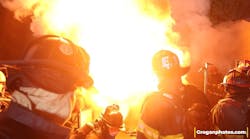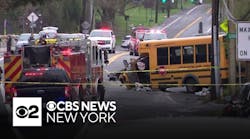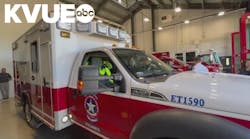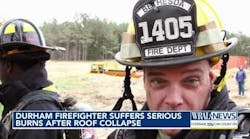January 21, 2010:
Today was an absolute BLAST! We enjoyed a field trip to the Dakota County Technical College campus in Rosemount, Minnesota to attend an Emergency Vehicle Operators Course. We arrived at Saint Paul Fire Training Center early, and fired up a few of the reserve fire engines from the fleet (after shoveling snow and ice from the rigs – we REALLY have to get a heated storage garage for this equipment. These reserve rigs sit outside in all seasons, yet we rely on them to replace our front line equipment when they have to go in to the shop for maintenance or repairs). The Fire Academy recruits and instructors drove quite a caravan for the trip to Rosemount: 3 old engines, a reserve ambulance, and two passenger vans we borrowed from our partners, the Saint Paul Police Department.
We bumped and rattled and shimmied our way to the college campus. Then we sat in a classroom for presentations about defensive driving techniques, handling characteristics of large vehicles, legal implications of using sirens and emergency lights, and the challenges of driving on ice and snow. The lead instructor was Harvey Biron, a former West Saint Paul Police Officer and supervisor, and the former Police Chief and EMS Director for Cannon Falls, MN. I had not met Harvey before, but we had mutual friends in public safety. Harvey is also well known by my sister’s family, who are all members of the Cannon Falls Rescue Service (EMS).
Following a short lunch (we took our old fire engine in to Rosemount for a Subway sandwich), we returned for the FUN part of the day: a series of emergency driving courses set up on the college grounds. Throughout the afternoon, my classmates and I took turns driving fire engines and ambulances through 4 different emergency driving scenarios (we did not use the Police van, out of respect for our brothers and sisters in blue!). The 4 scenarios were:
- The Serpentine Course: you drive the engine or ambulance down a straight road, weaving in between orange traffic cones. Object: don’t knock over the cones as you weave between them! It sounds easy, and it is.......as long as you’re going slowly enough. Each student had the opportunity to go through the course a half dozen times or so, gradually increasing the speed of the vehicle. The distance between the cones remained constant.
- The “Skid Pad” was a straight course followed by a quick dog-leg turn at the end. The surface of the pad was pure ice! A student would drive down the straight course and “hit the brakes” just before the dog-leg course. Students rotated between vehicles equipped with Antilock Braking Systems (ABS) and those without. The object was to experience the difference between the two braking systems. For those vehicles without ABS, students had the opportunity to practice “threshold braking” techniques: braking “hard” until just before the wheels locked up into a skid, then easing off the brakes momentarily to make the dogleg turn, then squeezing down on the brakes again until just before the wheels started to skid again.
- The Backing Course allowed students to practice backing rigs through a serpentine course and around a circular course. The object was to learn how to use the mirrors effectively and to judge the pivot point of the vehicle (the rear wheels! When the rear wheels reached the object you wanted to steer around, you turned the steering wheel to begin your turn).
- Finally, the Decision Course. Students approached a traffic light that indicated whether you needed to steer sharply to the left or right in order to avoid a simulated road obstacle. Again, students went through the course a number of times, increasing speed from about 20 mph to 35 mph. Decision making and reaction time were critical factors in avoiding the “obstacle.”
I was in a 1980’s fire engine formerly owned by the Inver Grove Heights Fire Department. I rode with Training Officer Clarence Hawkins. When I saw “Hawk” sitting in the rig ready to go, I thought to myself, “Well, if anyone would know how to make that rig fly, it would be Hawk.” He is the Department’s resident collector of fire department memorabilia, fire stream appliances, fire trucks, and other old antiques and collectibles. I could not pass up the chance to learn some tricks of the trade from him.
As I was driving around with Hawk, I reflected on how long it had been since I last drove a fire truck.....20 years ago in the Grand Lake Township VFD. It was fun to back in the driver’s seat, sitting up high, and cranking that big wheel around the sharp corners of the course! I think I only knocked over one cone all afternoon – on the glare ice of the dog-leg turn on the skid pad......no ABS on that old rig, and when the brakes lock up on the ice, the rig goes in a straight line!
Some of the key lessons learned during the afternoon:
- When avoiding an obstacle on the road (the cones, for instance), don’t look AT the cone, look BEYOND the cones to find the path that takes you AROUND the obstacle. Drivers tend to focus on a road obstacle. People to steer TOWARDS what they’re looking at, so they tend to hit what they focus on!
- Sometimes, “hitting the brakes” is NOT the best way to avoid an obstacle. STEERING is the key avoidance action, so take your foot off the gas, and STEER around the obstacle.....keep your foot off the brake.
- It is possible to slide sideways in a 1980 Ford E-One fire engine without tipping it over!
- A quarter turn of the steering wheel is all you need to avoid an obstacle in the road at 20-35 mph. Too many drivers “overcorrect,” by turning the wheel too violently, and end up getting into an accident anyway.
- When backing and turning, start turning the wheel when your back wheels reach the object you’re turning around (the back wheels are the pivot point of the turn).
At the end of the day we turned our rickety, rattling caravan north to head back to the Saint Paul Fire Training Center. Cold drizzle and sleet were raining down on us as we maneuvered through traffic on Highway 52, but the conversations recapped the “field trip” atmosphere that prevailed during this enjoyable, educational training day. Our conversations reflected our buoyant spirits in spite of the gloomy weather.
Week 11 was nearly over, and the week had included live fire training, ice water rescue, and “hot dogging” around in fire rigs and ambulances. Tomorrow promised additional “hands-on” evolutions in a donated building on Sherburne Avenue.......yep, this was definitely “Pair-ree,” and none of us would ever be content to be “back on the farm” now!!
Tim






